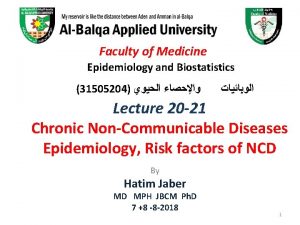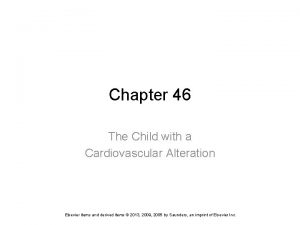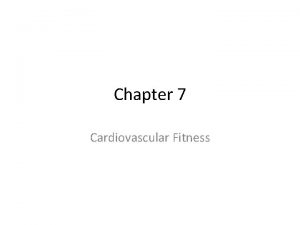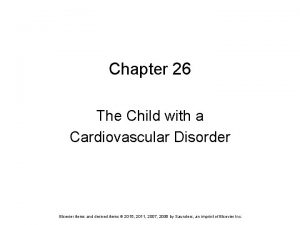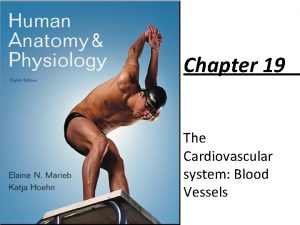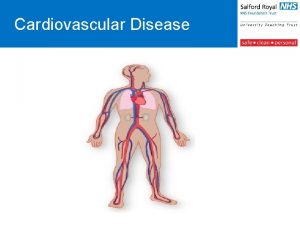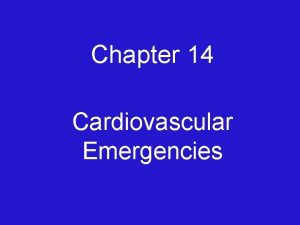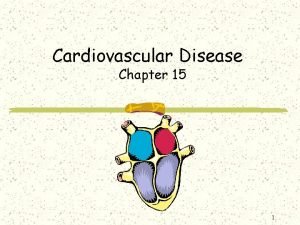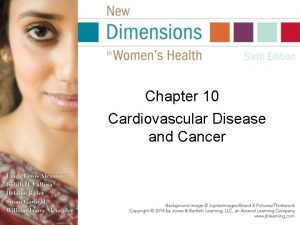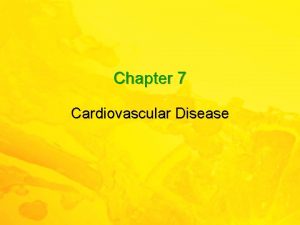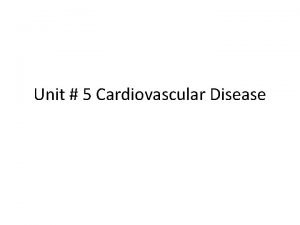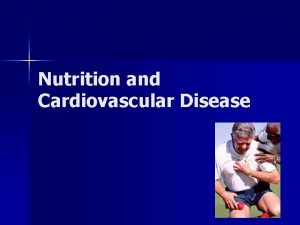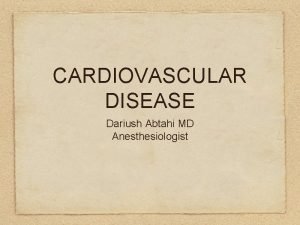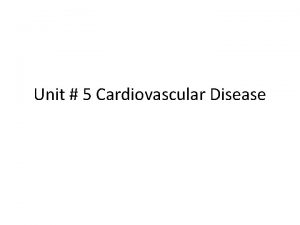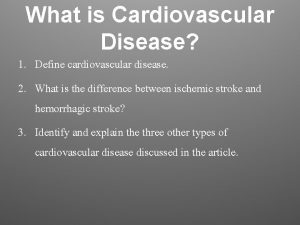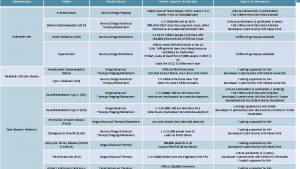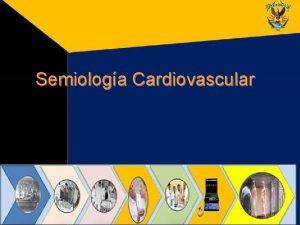Chapter 7 Cardiovascular Disease Cardiovascular disease accounts for























- Slides: 23

Chapter 7 Cardiovascular Disease Cardiovascular disease accounts for 1 in every 3 deaths in the US. 1 death every 40 seconds

Aerobic vs. Anaerobic ● Aerobic Activities: ◦ Steady enough activity to allow your heart to supply enough oxygen to your muscles ● Aerobic ◦ Literally means with oxygen ◦ Endurance type activities

Aerobic vs. Anaerobic ● Anaerobic Activities ◦ Activity that is so intense that your body cannot supply adequate oxygen to sustain it for long periods of time. For this reason it is typically done in short bursts. ● Anaerobic ◦ Literally means without oxygen ◦ Sprint type activities

Cholesterol ● Cholesterol: ◦ a fatlike substance found in meats, dairy and egg yolks. ● Lipoproteins: ◦ Carriers of cholesterol in the blood

Cholesterol ● Two types of lipoproteins ◦ HDL �High-density lipoproteins: good cholesterol; help prevent atherosclerosis by carrying excess LDLs out of the body. ● LDL ◦ Low-density lipoproteins: bad cholesterol; stay in the body and can cause atherosclerosis

Cardiovascular Fitness ● What types of food have good/bad types of cholesterol? ◦ Bad: fried, fatty foods (high levels of LDLs) ◦ Good: grains, omega 3 fatty-acids, nuts ● Why is it important to monitor your heart rate to make sure it is in the target heart rate zone? ◦ Because if you below or above the heart rate zone, your exercise session may not improve aerobic fitness.

Cardiovascular Fitness ● Explain how cardiovascular fitness helps your cardiovascular system work more efficiently and helps prevent cardiovascular diseases. ◦ Good aerobic fitness strengthens the heart, allowing it to pump more blood per beat; blood vessels remain healthy; and together, these factors reduce the risk of heart diseases. ● Why can cholesterol be dangerous to your health? ◦ High levels of LDLs can cause atherosclerosis and heart disease ● Why should you do more than one self-assessment for determining cardiovascular fitness? ◦ You may not be good at one type of fitness test (aerobic running) but may be good at walking, swimming and biking.

Cardiovascular vs. Respiratory ● Cardiovascular system ◦ The body system that includes your heart, blood vessels and the blood. ● Respiratory system ◦ The body system that includes your lungs and air passages. ● Vessels ◦ Three types �Veins: carry blood to the heart �Arteries: carry the blood to the body away from the heart �Capillaries: smallest part of the vessels and transition the blood from the arteries to the veins

MUSCULAR SYSTEM

Active Aerobics/Recreation ● Active Aerobics: ◦ Activities that are vigorous enough to bring your heart rate into the target zone. ◦ Aerobic: �Means “with oxygen” ● Active Recreation: ◦ Activities that are fun and typically non-competitive and are not meant for fitness, but can enhance one’s level of fitness. YOU LIVE IN THE BEST STATE FOR ACTIVE RECREATION!!! USE IT!

Leisure Time & Recreational Activity ● Leisure time: ◦ Time free from work, school, homework and jobs ● Recreational activity: ◦ Activity done during leisure time to refresh and rejuvenate you. ● Examples: ◦ Video games ◦ Watching movies ◦ Facebook

Circuit Training: �Performing several different activities one after another during a workout

Active Aerobics ● Examples of Active Aerobics: ◦ ◦ ◦ Running P 90 X Biking Tae Bo Swimming Skating Any activity that is going to elevate your heart rate into the target zone. Examples of Active Recreation �Backpacking �Hiking Longboard �Rock climbing Snowboarding Skiing Paddleboarding Kayak

Active Aerobic vs Recreation Active Aerobic ◦ ◦ ◦ Running Biking Swimming Skating P 90 X Tae Bo Recreation Activities- LIMIT ◦ Video games ◦ Watching movies ◦ Facebook

Active Aerobics and Active Recreation ▶ What are some good safety tips for performing active aerobics and active recreation? ◦ ◦ ◦ Wear proper safety equipment Use safe equipment Get proper instruction Perform within the limits of your current skills Plan ahead

Active Aerobics vs. Active Recreation ● Why is it important to include in your activity plan, choices from the active aerobics and active recreation part of the Physical Activity Pyramid? ◦ For variety – active recreation can be done as lifestyle activities, whereas aerobic exercise can be more vigorous and structured. ● Why would active aerobics be one of the most beneficial types of activity? ◦ It directly enhances and improves your cardiovascular system

Boys vs. Girls? ? ● According the statistics, 72% of boys and 52% of girls are vigorously active 3 x a week. Why do you think girls are lower than boys? What suggestions do you have that might help change these statistics? ◦ More boys are involved in varsity sports than girls and their practices would be considered vigorous activity. Additionally boys are more likely to go out and play sports with their friends than girls.

Skill and Sports ● 6 parts of skill-related fitness ◦ 1. Agility: ability to change the position of your body quickly and to control your body’s movements ◦ 2. Balance: ability to keep an upright posture while standing still or moving ◦ 3. Coordination: ability to use your senses together with your body parts or use two or more body parts together ◦ 4. Power: ability to use strength quickly ◦ 5. Reaction Time: amount of time it takes to move once you realize you need to act ◦ 6. Speed: ability to perform a movement or cover a distance in a short period of time

Sports and Fitness ● What sports are best for developing each of the 5 parts of health-related fitness? ◦ CV Fitness/Body Fatness: �Cross Country and Track & Field ◦ Strength: �Football, wrestling ◦ Muscular Endurance: �Basketball, cross country, soccer ◦ Flexibility: �Dance, gymnastics

Skill and Sports ● What are some ways to self-assess your skillrelated fitness? ◦ Doing tests of agility, balance and power ◦ Football combines, vertical test, ladders, cones ● What is the difference between skill and skillrelated physical fitness? ◦ Skill-related fitness is fitness related to how well a skill can be performed (t-drill); a skill is a talent you possess. (fast) ◦ Sport Skill-catching, throwing and kicking

Sports and Fitness ● Sports ◦ 3 guidelines for choosing sports : � 1. Sport you enjoy � 2. A sport you may have success at � 3. A sport that friends are involved in ◦ Why is it important to be physically fit when participating in sports? �Fitness can improve sport performance and decrease the chance of injury

Sports and Fitness ● Sports ◦ Individual sports: �Sports that you can participate in by yourself �Examples: �Running �Swimming �Biking �Bowling �XC Skiing �Skiing/Snowboarding

Sports and Fitness ● Sports ◦ Lifetime and recreational sports: �Sports that can be done when you grow older �Examples: �Running �Swimming �Biking �Golf �Bowling ◦ Team sports �What do you think the largest age group to play team sports is? �Children & Teenagers �You need to learn individual sports that you can play as you get older.
 Chapter 11 the cardiovascular system
Chapter 11 the cardiovascular system Cardiovascular disease risk factor
Cardiovascular disease risk factor Capillary bed
Capillary bed Cengage chapter 5
Cengage chapter 5 Chapter 46 the child with a cardiovascular alteration
Chapter 46 the child with a cardiovascular alteration The child with a cardiovascular disorder chapter 26
The child with a cardiovascular disorder chapter 26 Chapter 25 assessment of cardiovascular function
Chapter 25 assessment of cardiovascular function Chapter 11 the cardiovascular system figure 11-3
Chapter 11 the cardiovascular system figure 11-3 Figure 11-8 arteries
Figure 11-8 arteries Chapter 11 the cardiovascular system
Chapter 11 the cardiovascular system Cardiovascular system diseases and disorders chapter 8
Cardiovascular system diseases and disorders chapter 8 Chapter 7 cardiovascular fitness
Chapter 7 cardiovascular fitness Chapter 16 cardiovascular emergencies
Chapter 16 cardiovascular emergencies Chapter 13 cardiovascular system
Chapter 13 cardiovascular system Chapter 11 the cardiovascular system figure 11-2
Chapter 11 the cardiovascular system figure 11-2 Cardiovascular system
Cardiovascular system Chapter 26 the child with a cardiovascular disorder
Chapter 26 the child with a cardiovascular disorder True capillaries definition
True capillaries definition Communicable disease and non communicable disease
Communicable disease and non communicable disease Iso 22301 utbildning
Iso 22301 utbildning Typiska drag för en novell
Typiska drag för en novell Nationell inriktning för artificiell intelligens
Nationell inriktning för artificiell intelligens Vad står k.r.å.k.a.n för
Vad står k.r.å.k.a.n för Shingelfrisyren
Shingelfrisyren

